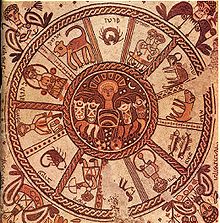- Mazzaroth
-
 6th-century depiction of the zodiac, mosaic in Beit Alpha, Israel.
6th-century depiction of the zodiac, mosaic in Beit Alpha, Israel.
Mazzaroth (Mazarot מַזָּרֹות, LXX μαζουρωθ) is a hapax legomenon of he Hebrew Bible, found in Job 38:31-32. The similar word mazalot (מַּזָּלֹות) in 2 Kings 23:3-5 may be related.
The word's precise meaning is uncertain[1] but its context is that of astronomical constellations, and it is often interpreted as a term for the zodiac, or the zodiacal constellations as a group.[2]
In Yiddish, the term mazalot came to be used in the sense of "astrology" in general, surviving in the expression "mazel tov," meaning "good luck."[3]
Contents
Biblical context
The appearance of the word in the Book of Job appears in the context of various astronomical phenomena:
- "Canst thou bind the chains of the Pleiades, or loose the bands of Orion? Canst thou lead forth the Mazzaroth in their season? Or canst thou guide the Bear with her sons?" (JPS 1917)[4]
The related word mazalot (מַּזָּלֹות) in 2 Kings may have a different meaning, and is often translated differently, with the linkage of this word to the planets or the zodiac being more widely held (in Kabbalistic astrology, mazalot was also used for astrology in general,[5] and the word may be related to the Assyrian manzaltu, "station"[6]):
- And the king stood on the platform, and made a covenant before the LORD, to walk after the LORD, and to keep His commandments, and His testimonies, and His statutes, with all his heart, and all his soul, to confirm the words of this covenant that were written in this book; and all the people stood to the covenant. And the king commanded Hilkiah the high priest, and the priests of the second order, and the keepers of the door, to bring forth out of the temple of the LORD all the vessels that were made for Baal, and for the Asherah, and for all the host of heaven; and he burned them without Jerusalem in the fields of Kidron, and carried the ashes of them unto Beth-el. And he put down the idolatrous priests, whom the kings of Judah had ordained to offer in the high places in the cities of Judah, and in the places round about Jerusalem; them also that offered unto Baal, to the sun, and to the moon, and to the constellations, and to all the host of heaven.[7]
The Septuagint, however, uses the transliteration mazzaroth (μαζουρωθ) again at this point.[8]
That star signs are taken credit for by the God of the bible is acknowledged in the beginning. Genesis 1:14, And God said, "Let there be lights in the expanse of the heavens to separate the day from the night. And let them be for signs and for seasons, (or appointed times) and for days and years (ESV)[9]
Translation
The word is traditionally (following LXX) left untranslated (ABC, ACV, AKJ, ASV, BBE, BIB, ESV, GNV, HNV, JPS, K21, KJG, KJR, KJV, NAB, NKJ, NRS, NWT, RSV, RWB, TMB, TNK, UPD, WEB, YLT, LXE, ZIK), but some modern English Bible translations render it as "zodiac" (AMP, CJB, EMP, LEE); others have "constellations" (CJB, CSB, DBY, NET, ERV, GWN, LEE, LIT, MKJ, NAS, NAU, NIB, NIV, TNV, WEV) or "stars" (CEV, NCB, NIR, NLV, TEV).
But as the Latin Vulgate renders the word as "luciferum", there are alternative English translations as "morning star" (CVB, TRC, also Luther's 1545 German translation, as Morgenstern); "day star" (DRA); "Venus" (MSG); "Crown season" (NJB); "sequence of seasons" (NLT); "Lucifer, 'that is, dai sterre (day star)" (Wycliffe's Bible). WES[clarification needed] gives "stars in the southern signs".
Translators' Notes given in individual translations are>
- Geneva: Certain stars so called, some think they were the twelve signs.
- KJV/KGB: {Mazzaroth: or, the twelve signs}
- NAS/NAU: perh. "a constellation"
- NET: The word מַּזָּלֹות; (mazzarot) is taken by some to refer to the constellations (see 2 Kings 23:5), and by others as connected to the word for "crown," and so "corona."
- NIB/NIV: {32 Or the morning star in its season}
See also
- Hebrew astronomy
- Jewish views on astrology
References
- ^ Jewish Encyclopedia: Constellations, accessed 2010-02-13. Norman C. Habel, The Book of Job: A Commentary, Westminster John Knox Press, 1985, p. 523, ISBN 0664222188.
- ^ Franz Delitzsch, Biblical Commentary on the Book of Job, Volume 2, T. & T. Clark, 1866, p. 324.
- ^ Jewish Encyclopedia: Astrology, accessed 2010-02-13.
- ^ The Hebrew Bible in English according to the JPS 1917 Edition, Job Chapter 38.
- ^ Tamar Rudavsky, Time Matters: Time, Creation, and Cosmology in Medieval Jewish Philosophy, SUNY Press, 2000, p. 25, ISBN 0791444538.
- ^ James Hastings (ed), Encyclopaedia of Religion and Ethics, Part 23, Kessinger Publishing (reprint), 2003, pp. 82–83, ISBN 0766137031.
- ^ The Hebrew Bible in English according to the JPS 1917 Edition, 2 Kings Chapter 23.
- ^ The Greek Old Testament (Septuagint), Kings IV, Chapter 23.
- ^ Genesis 1:14 (English Standard Version)
Categories:- Hebrew Bible words and phrases
- History of astronomy
- History of astrology
Wikimedia Foundation. 2010.
